Did you know that Bulgaria is renowned for its sacred natural sites, which are not only spiritually significant but also play a crucial role in biodiversity conservation? These sacred places are a testament to Bulgaria’s rich cultural heritage and are surrounded by stunning landscapes and diverse ecosystems.
- Bulgaria is home to sacred natural sites that combine cultural and religious significance with rich biodiversity.
- These sites contribute to the conservation of Bulgaria’s unique ecosystems and wildlife.
- Exploring these sacred landscapes provides an opportunity to appreciate the country’s natural beauty and spiritual landmarks.
- Bulgaria’s natural heritage is protected through wildlife preservation and eco-friendly tourism initiatives.
- Conservation efforts in Bulgaria focus on maintaining the balance between human activities and the preservation of natural ecosystems.
National Parks of Bulgaria
Among the protected areas in Bulgaria, the National Parks stand out as guardians of the country’s natural treasures. These parks are dedicated to conserving biodiversity and promoting the responsible use of natural resources, offering visitors unique opportunities to explore and appreciate the majestic beauty of Bulgaria’s landscapes.
Rila National Park
Rila National Park is a jewel in Bulgaria’s crown, encompassing the towering Rila Mountains and its iconic Seven Rila Lakes. With its diverse flora and fauna, including rare and endemic species, the park is a haven for nature lovers and outdoor enthusiasts. Hiking enthusiasts can conquer Mount Vihren, the highest peak in the park, while nature explorers can witness the breathtaking beauty of alpine meadows, dense forests, and glacial landscapes.
Pirin National Park
Pirin National Park is a pristine wilderness that captivates visitors with its untouched landscapes and remarkable biodiversity. Home to the elusive Balkan chamois and dotted with enchanting alpine lakes, the park offers a sanctuary for wildlife and a playground for adventurers. Hikers can explore its network of trails and witness panoramic views of rugged peaks, lush meadows, and cascading waterfalls, immersing themselves in the harmonious blend of nature and tranquility.
Central Balkan National Park
Central Balkan National Park exemplifies the harmonious coexistence of nature and humanity. Spanning diverse ecosystems, including dense forests and steep cliffs, the park provides a refuge for endangered species and serves as a vital watershed. Visitors can marvel at the mystical beauty of the Saeva Dupka Cave, with its mesmerizing stalagmites and underground wonders, or embark on hikes through multifunctional forests, appreciating the park’s ecological significance and sustainable management practices.
Natural Parks of Bulgaria
In addition to the National Parks, Bulgaria is blessed with 11 Natural Parks that offer a more flexible approach to resource utilization while preserving both the biological and landscape diversity of the country. These natural parks, including Belasitsa, Vitosha, and Strandzha, constitute a mosaic of protected areas across Bulgaria, each playing a vital role in the conservation of the nation’s diverse flora and fauna.
Belasitsa Natural Park is located in the southwestern part of Bulgaria and spans the Belasitsa Mountain range. It is known for its breathtaking landscapes, diverse ecosystems, and rich biodiversity. The park serves as a refuge for numerous rare and endangered plant and animal species, making it a haven for nature enthusiasts and researchers alike.
Vitosha Natural Park, situated just a stone’s throw away from Bulgaria’s capital city, Sofia, is a true natural gem. Its proximity to urban areas allows visitors to easily access its wonders, including the majestic Boyana Waterfall and the dramatic gorges of Vitosha. The park offers a range of outdoor activities, such as hiking and wildlife observation, providing a refreshing escape into nature.
Strandzha Natural Park, located in the southeastern part of Bulgaria, is a combination of dense forests, towering peaks, and pristine coastline. Its unique blend of terrestrial and marine ecosystems makes it a paradise for biodiversity. The park is home to rare and endemic species, including the Strandzha fire salamander and the iconic European spiny lobster.
| Natural Park |
Location |
Main Attractions |
| Belasitsa Natural Park |
Southwestern Bulgaria |
Breathtaking landscapes, rich biodiversity |
| Vitosha Natural Park |
Near Sofia, Western Bulgaria |
Boyana Waterfall, dramatic gorges |
| Strandzha Natural Park |
Southeastern Bulgaria |
Dense forests, pristine coastline |
These Natural Parks are essential for the preservation of Bulgaria’s natural heritage and contribute to the country’s efforts in biodiversity conservation. They serve as important ecological corridors, connecting different habitats and allowing for the movement of wildlife. The Natural Parks also play a significant role in promoting sustainable tourism and raising awareness about the importance of protecting our natural environments.
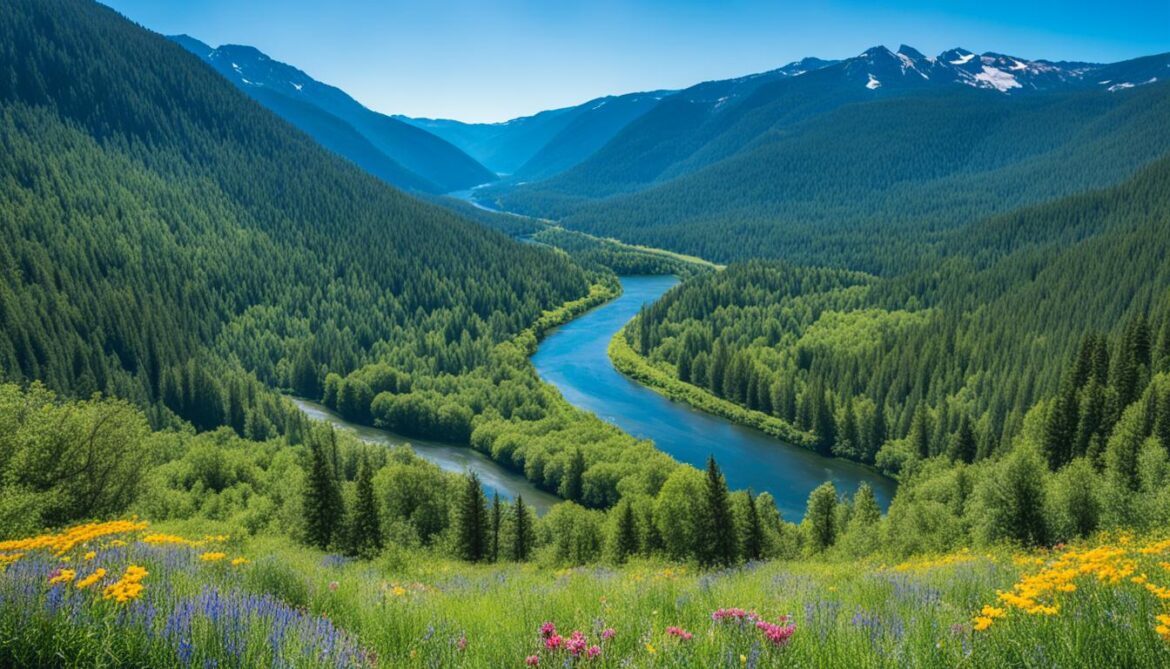
Rila National Park: A Majestic Mountain Haven
Rila National Park, nestled in the heart of Bulgaria, is a true paradise for nature lovers and outdoor enthusiasts. As a designated UNESCO World Heritage Site, this majestic mountain haven offers breathtaking landscapes, crystal-clear lakes, and a diverse range of flora and fauna.
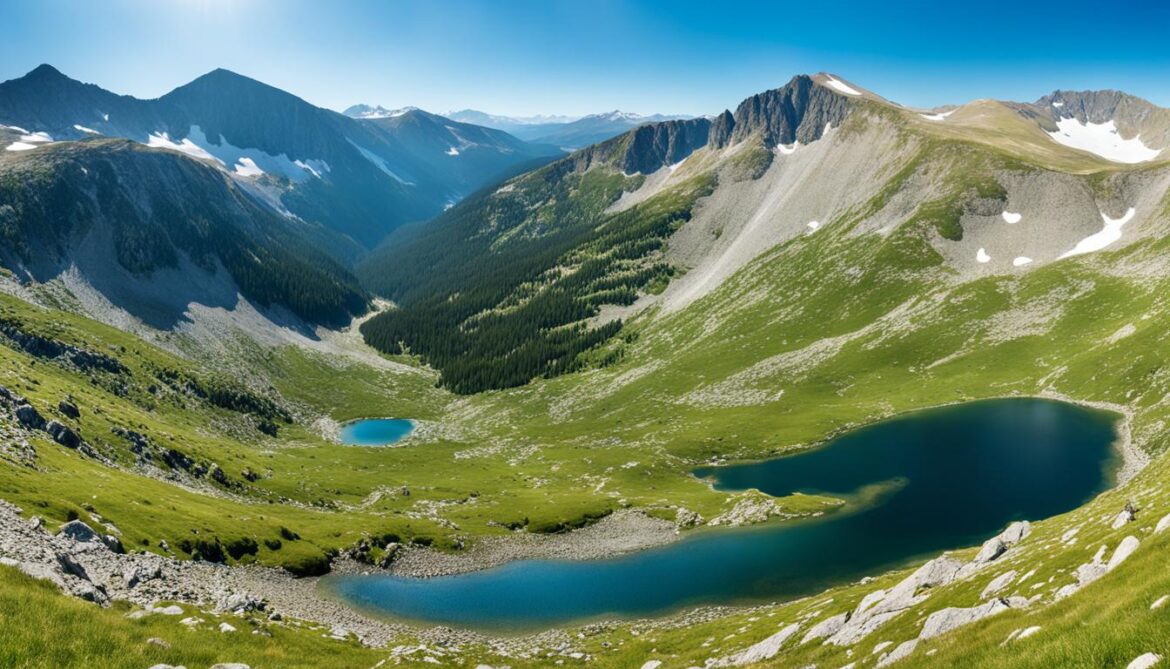
One of the most iconic features of Rila National Park is the famous Seven Rila Lakes. This chain of glacial lakes, situated on different levels, enchants visitors with its stunning beauty and serene atmosphere. Each lake has its unique charm, and hiking around them provides an excellent opportunity to immerse oneself in the unparalleled natural surroundings.
Mount Vihren, the highest peak in the Rila Mountains, stands tall within the boundaries of the national park. It offers a challenging yet rewarding hiking experience for adventure seekers. From its summit, hikers are rewarded with panoramic views that extend far beyond the park, allowing them to marvel at the beauty of the Bulgarian landscape.
“Rila National Park is a sanctuary of tranquility and natural wonders. The park’s strict management regime ensures the preservation of biodiversity, making it a vital stronghold for conservation efforts in Bulgaria.”
Whether you’re an avid hiker, a nature enthusiast, or simply seeking to reconnect with the great outdoors, Rila National Park offers a myriad of opportunities for nature exploration and adventure. The park boasts an extensive network of trails, catering to both beginners and experienced trekkers. Embarking on a hike in Rila National Park allows you to witness the park’s rich biodiversity firsthand and create memories that will last a lifetime.
Rila National Park: Biodiversity Conservation
Rila National Park plays a pivotal role in the conservation of Bulgaria’s diverse ecosystems and wildlife. The park’s strict management practices ensure the protection of endangered species and their habitats, contributing to biodiversity preservation. By promoting responsible and sustainable tourism practices, the park strikes a delicate balance between nature conservation and allowing visitors to experience the park’s natural wonders.
The preservation of Rila National Park and its biodiversity is not only crucial for the local ecosystem but also offers valuable lessons in the global effort to protect and conserve our planet’s natural heritage. By exploring Rila National Park, visitors not only immerse themselves in nature’s beauty but also contribute to the ongoing conservation efforts in Bulgaria and beyond.
| Hiking Trails |
Difficulty Level |
| Seven Rila Lakes Circuit |
Moderate |
| Mount Vihren Summit Trail |
Challenging |
| Maliovitsa Peak Trail |
Moderate to Difficult |
No matter which trail you choose to explore, you’re sure to encounter the wonders of Rila National Park. From vibrant alpine meadows to rugged peaks, the park offers an incredible range of landscapes to discover and enjoy.
Embarking on a hiking adventure in Rila National Park not only provides an opportunity for physical activity and exploration but also fosters a deeper appreciation for the importance of biodiversity conservation. By experiencing the park’s natural wonders firsthand and supporting responsible tourism practices, visitors become advocates for the preservation of Bulgaria’s natural heritage.
Pirin National Park: Untouched Wilderness and Natural Wonders
Pirin National Park is an extraordinary sanctuary that showcases the untouched wilderness and inherent natural wonders of Bulgaria. Nestled in the breathtaking Pirin Mountains, this preserved park is a haven for nature enthusiasts and wildlife lovers alike.
The park’s diverse flora and fauna create a harmonious ecosystem that thrives in this unspoiled landscape. Among the inhabitants of Pirin National Park is the elusive Balkan chamois, a remarkable mountain goat species that epitomizes the park’s biodiversity.
For hiking enthusiasts, Pirin National Park offers an extensive network of trails that lead to hidden alpine lakes, mesmerizing waterfalls, and breathtaking vistas. Whether it’s a leisurely stroll or a challenging trek, the park caters to all levels of hikers, providing unforgettable experiences amidst nature’s wonders.
“Pirin National Park is a testament to the remarkable beauty and ecological preservation found in Bulgaria’s protected areas. It offers a unique opportunity to immerse oneself in the splendor of untouched wilderness.” – Nature Enthusiast
Alpine Lakes of Pirin National Park
One of the highlights of Pirin National Park is its stunning alpine lakes. These picturesque bodies of water are nestled among the rugged mountain peaks, providing a serene and captivating experience for visitors. Some of the renowned alpine lakes in the park include:
- The glacial lake of Popovo
- The turquoise waters of Okoto
- The mirrored beauty of Banderishki
- The enchanting Dupoto
The alpine lakes of Pirin National Park offer a tranquil respite and a chance to connect with the pristine natural environment that surrounds them.
Ecological Preservation and Sustainability
Pirin National Park stands as a testament to Bulgaria’s commitment to ecological preservation. The park’s strict conservation measures and sustainable management practices ensure the protection of its unique ecosystems for future generations to cherish.
Through responsible tourism and environmental education initiatives, Pirin National Park strives to raise awareness about the importance of preserving natural habitats and safeguarding the fragile balance between human activities and wildlife conservation.
| Key Features |
Benefits |
| Balkan Chamois |
Preservation of a threatened species |
| Alpine Lakes |
Unique natural attractions for visitors |
| Hiking Trails |
Opportunities for outdoor enthusiasts to explore the stunning landscapes |
| Ecological Preservation |
Conservation of biodiversity and natural ecosystems |
Visiting Pirin National Park not only offers a chance to immerse oneself in untouched wilderness and marvel at natural wonders but also contributes to the collective effort of preserving Bulgaria’s extraordinary ecological heritage.
Central Balkan National Park: The Harmony of Nature and Humanity
Central Balkan National Park (central balkan national park) is a testament to the harmonious coexistence of nature and humanity. Nestled in the heart of Bulgaria, this park showcases the stunning beauty and ecological diversity of the Balkan Mountains. As one of the largest protected areas in the country, it plays a vital role in the (ecological preservation) of Bulgaria’s natural heritage.
One of the park’s standout attractions is the mystical Saeva Dupka Cave (saeva dupka cave). This underground wonder invites visitors to explore its subterranean wonders with its elaborate chambers, stunning stalactites and stalagmites, and stories of ancient folklore. It is a place that fascinates both nature enthusiasts and curious explorers alike.
The incredibly diverse multifunctional forests of Central Balkan National Park provide a habitat for a wide range of plant and animal species. These forests serve as a protective levee for local communities, safeguarding them from soil erosion and natural hazards such as floods. Additionally, they act as a refuge for endangered species and contribute to the overall biodiversity of the park.
In the words of John Muir, “In every walk with nature, one receives far more than he seeks.” This sentiment resonates within Central Balkan National Park, where the harmony between nature and humanity is palpable.
Central Balkan National Park (central balkan national park) is a shining example of sustainable tourism practices. It offers a range of activities for visitors, including hiking, camping, wildlife observation, and educational programs. These activities are carefully managed to ensure minimal impact on the environment, allowing future generations to experience the park’s wonders.
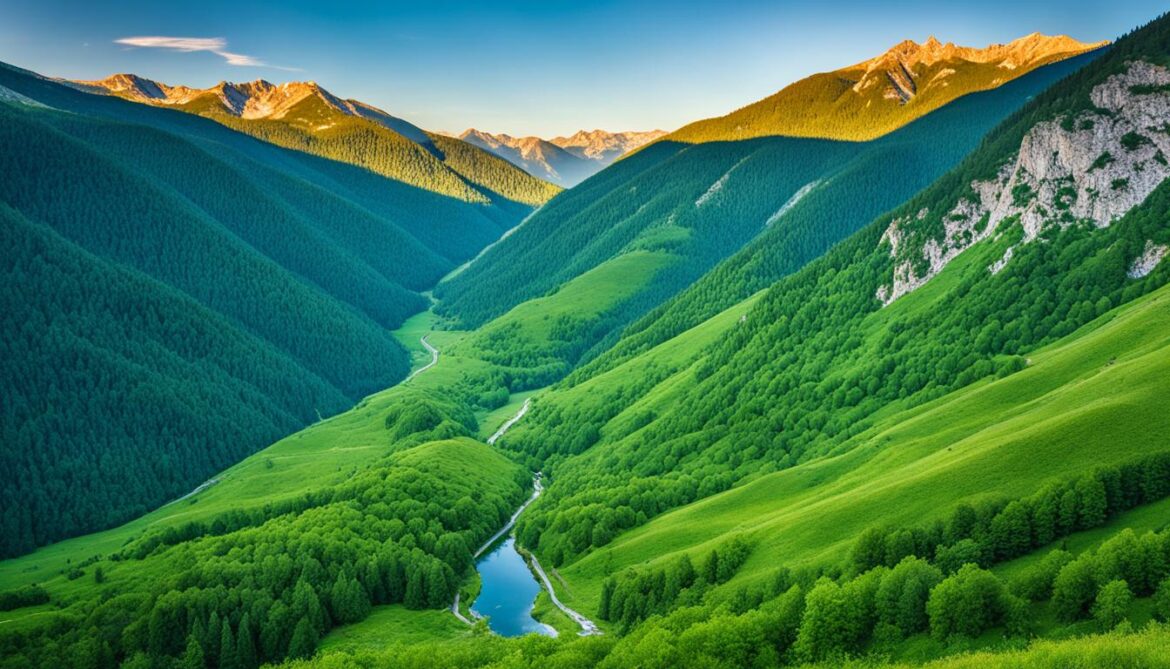
The Importance of Ecological Preservation
The preservation of Central Balkan National Park is not only about protecting the natural beauty of the region but also about safeguarding ecosystem services that are crucial for our planet’s well-being. The park’s forests help regulate the climate, purify the air we breathe, and provide a home for countless species of wildlife. Preserving these ecosystems is essential to maintain the delicate balance of our planet’s biodiversity.
In conclusion, Central Balkan National Park serves as a shining example of the harmonious coexistence between nature and humanity. Through its mystical caves, multifunctional forests, and commitment to ecological preservation, the park offers a unique and sustainable tourism experience. By visiting and supporting this magnificent park, we can contribute to the conservation efforts and ensure that future generations can continue to enjoy its natural wonders.
Balgarka Natural Park: Diverse Landscapes and Cultural Heritage
Balgarka Natural Park is a captivating landscape that showcases diverse terrains and cultural heritage. This scenic park is nestled in the heart of Bulgaria and offers visitors a unique opportunity to immerse themselves in both natural beauty and rich cultural traditions.
One of the highlights of Balgarka Natural Park is its sacred groves, which are protected areas associated with cultural and religious significance. These groves serve as important sanctuaries for local communities and are home to ancient rituals and traditions that have been passed down through generations. They provide a sense of connection to the past and preserve the cultural identity of the region.
The sacred groves in Balgarka Natural Park not only hold deep cultural significance but also play a vital role in nature conservation. These protected areas serve as havens for a wide variety of plant and animal species, contributing to the overall biodiversity of the park. By preserving these groves, we are not only safeguarding our cultural heritage but also ensuring the continued existence of diverse ecosystems for future generations.
Balgarka Natural Park offers a range of outdoor activities for visitors to enjoy. From hiking through lush forests to exploring hidden caves, there is something for everyone to experience in this natural haven. Nature lovers can marvel at the park’s diverse landscapes, including dramatic cliffs, cascading waterfalls, and panoramic views of the surrounding mountains.
Outdoor Activities in Balgarka Natural Park:
- Guided hikes through scenic trails
- Exploring ancient caves and rock formations
- Birdwatching opportunities
- Camping and picnicking in designated areas
- Photography and capturing the park’s beauty
Whether you are a nature enthusiast, history buff, or simply seeking a tranquil escape, Balgarka Natural Park offers a wealth of experiences for everyone. Immerse yourself in the diverse landscapes, explore sacred groves, and discover the cultural traditions that make this park truly unique.

Preserving Nature for Future Generations
Conservation efforts in Balgarka Natural Park are essential for maintaining the delicate balance between cultural heritage and nature conservation. By promoting sustainable tourism practices and raising awareness about the importance of biodiversity, we can ensure that this natural treasure remains protected for future generations to enjoy.
With its diverse landscapes, cultural significance, and commitment to nature conservation, Balgarka Natural Park is a must-visit destination for anyone seeking to explore the beauty of Bulgaria.
Vitosha Nature Park: A Refreshing Escape near Sofia
Vitosha Nature Park, located near Sofia, offers a refreshing escape into nature. The park features stunning waterfalls, including the magnificent Boyana Waterfall, and dramatic gorges carved by the forces of nature. Vitosha Nature Park is a paradise for outdoor activities such as hiking and provides breathtaking views of the surrounding landscapes. It is a perfect destination for those seeking a tranquil retreat close to the bustling city.
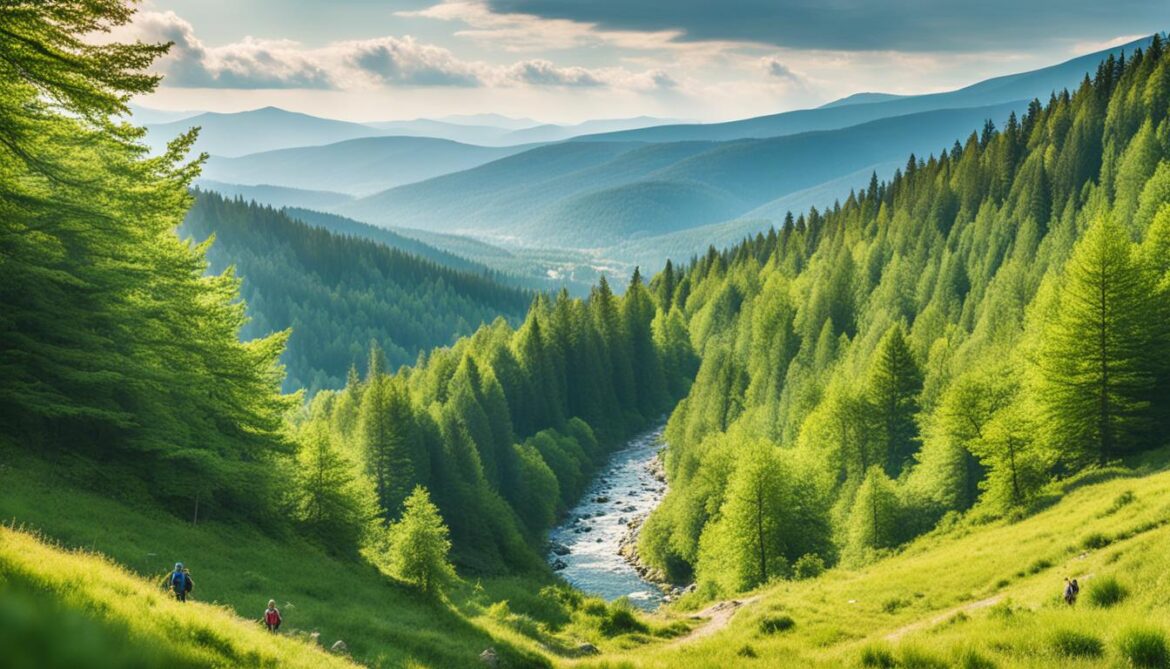
The star attraction of Vitosha Nature Park is the mesmerizing Boyana Waterfall, which cascades down the mountainside, creating a picturesque spectacle. Nestled amidst the lush greenery, the waterfall offers a rejuvenating experience for nature enthusiasts and photographers.
The park is also renowned for the gorges of Vitosha, characterized by their rugged beauty and impressive rock formations. These natural wonders provide a backdrop for thrilling hikes and exploration.
“Vitosha Nature Park is a true gem just a stone’s throw away from Sofia. It’s the perfect place to reconnect with nature and enjoy outdoor activities in a serene environment.”
– Sofia Outdoor Enthusiast
Outdoor Activities for Nature Exploration
Vitosha Nature Park offers a wide range of outdoor activities that cater to all ages and interests:
- Hiking: Explore the numerous trails that crisscross the park and lead to panoramic viewpoints, hidden valleys, and serene mountain lakes.
- Mountain Biking: Ride along designated paths and experience the thrill of navigating Vitosha’s rugged terrain.
- Rock Climbing: Challenge yourself on the cliffs and crags that dot the park, under the guidance of experienced instructors.
- Wildlife Watching: Keep an eye out for the park’s diverse wildlife, including foxes, deer, and various bird species.
Whether you’re an adrenaline junkie or a leisurely nature lover, Vitosha Nature Park offers an array of activities that allow you to immerse yourself in the beauty of the outdoors.
| Activity |
Description |
| Hiking |
Explore the park’s trails, ranging from easy walks to challenging treks, and discover breathtaking vistas along the way. |
| Mountain Biking |
Ride through Vitosha’s diverse landscapes, from dense forests to open meadows, and experience the thrill of off-road cycling. |
| Rock Climbing |
Test your skills on Vitosha’s cliffs and rock formations, with varying degrees of difficulty suitable for climbers of all levels. |
| Wildlife Watching |
Observe the park’s native wildlife, including deer, wild boars, and a variety of bird species, in their natural habitats. |
World Heritage Sites in Bulgaria
Bulgaria takes great pride in its collection of ten UNESCO World Heritage Sites, each showcasing the country’s rich cultural and historical heritage. These sites have gained international recognition for their outstanding universal value and continue to attract visitors from around the world.
“Bulgaria’s World Heritage Sites are architectural masterpieces that offer a glimpse into the fascinating history of the country.”
One of the most significant World Heritage Sites in Bulgaria is the Boyana Church. Located near Sofia, this medieval Orthodox church is renowned for its exceptional frescoes dating back to the 13th century. The detailed paintings, which depict scenes from the life of Christ and the lives of saints, are considered among the finest examples of Eastern European medieval art.
Another World Heritage Site of great historical significance is the Madara Rider. This unique rock relief stands on a steep cliff and dates back to the 8th century. It portrays a majestic horseman and is believed to depict a powerful ruler from the past. The Madara Rider is a symbol of Bulgaria’s ancient history and cultural heritage.
The Rila Monastery is yet another jewel in Bulgaria’s World Heritage Sites collection. Situated in the picturesque Rila Mountains, this Eastern Orthodox monastery is known for its breathtaking architecture and religious significance. Founded in the 10th century, the monastery is a true spiritual retreat and a symbol of Bulgarian identity.
The Thracian Tomb of Sveshtari adds a touch of mystery and intrigue to Bulgaria’s World Heritage Sites. This ancient tomb, dating back to the 3rd century BC, is adorned with exceptional wall paintings depicting funeral rituals and scenes from the afterlife. The elaborate architecture and artistic details make it a unique archaeological treasure.
These World Heritage Sites in Bulgaria offer visitors the opportunity to explore the country’s rich heritage and delve into its fascinating past. From the stunning frescoes of the Boyana Church to the ancient rock relief of the Madara Rider, each site provides a unique glimpse into Bulgaria’s cultural legacy.
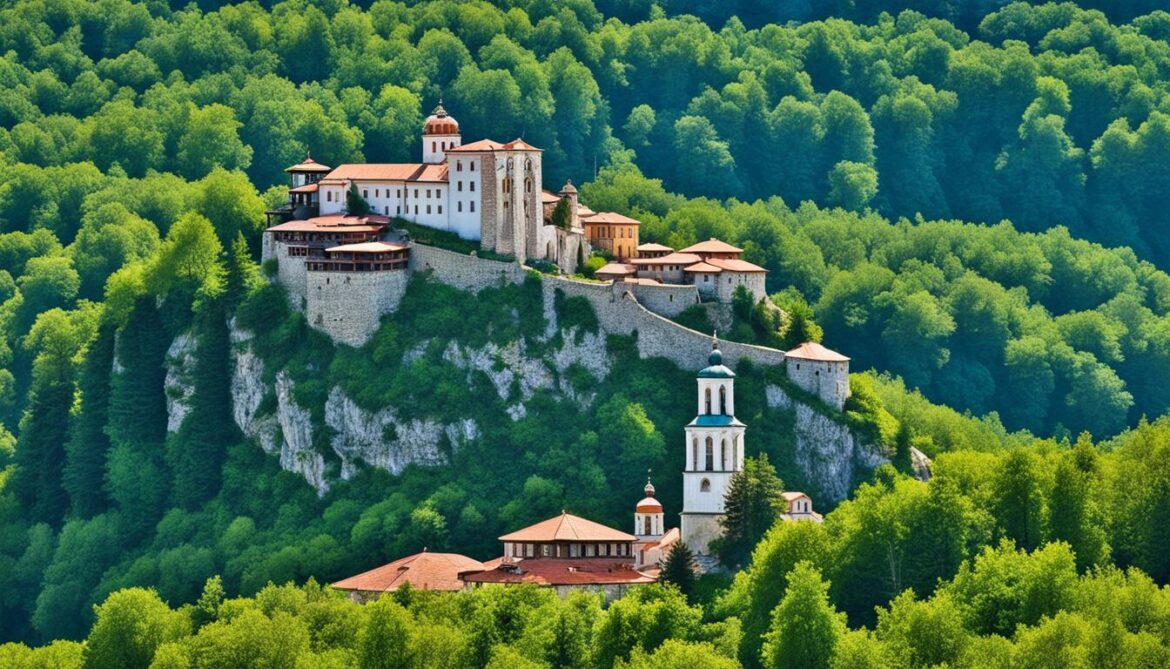
| World Heritage Site |
Location |
Description |
| Boyana Church |
Near Sofia |
A medieval Orthodox church with exceptional frescoes depicting scenes from the life of Christ and the lives of saints. |
| Madara Rider |
Madara, northeastern Bulgaria |
A unique rock relief dating back to the 8th century, depicting a horseman believed to be a powerful ruler from the past. |
| Rila Monastery |
Rila Mountains |
An Eastern Orthodox monastery founded in the 10th century, known for its stunning architecture and religious significance. |
| Thracian Tomb of Sveshtari |
Near Sveshtari, northeastern Bulgaria |
An ancient tomb from the 3rd century BC, adorned with exceptional wall paintings depicting funeral rituals and scenes from the afterlife. |
Importance of Sacred Natural Sites for Biodiversity Conservation
Sacred natural sites hold immense value in the conservation of biodiversity. These sites, which often hold cultural and religious significance, not only serve as spiritual landmarks but also fulfill vital roles in maintaining ecosystem services. From regulating air and water quality to preserving biological diversity and protecting endangered species, these sacred sites are essential components of Bulgaria’s natural ecosystems.
These sites act as guardians of the environment, providing crucial ecosystem services that directly impact both humans and wildlife. They contribute to the overall quality of air and water, sustaining the fragile balance of the natural world. Additionally, the preservation of these sites ensures the well-being and survival of various plant and animal species that depend on these sacred landscapes for their habitat.
The cultural significance of these sites cannot be overstated. They have played an integral role in the traditions and beliefs of local communities for centuries. By recognizing and protecting these sacred natural sites, we not only preserve our cultural heritage but also create opportunities for education and exploration.
“Sacred natural sites are an invaluable part of our cultural and natural heritage, serving as a connection between the past and the present, and holding the promise of a sustainable future.”
By promoting the conservation of these sites and integrating them into our efforts, we can develop a holistic approach to protect both biodiversity and cultural heritage. Through sustainable practices and responsible tourism, we can ensure the long-term preservation of these sacred natural sites, allowing future generations to appreciate their beauty and significance.
In Summary
Sacred natural sites are not only spiritual landmarks but also essential contributors to biodiversity conservation. They provide invaluable ecosystem services and support the preservation of biological diversity. Their cultural significance makes them an inherent part of our heritage. Protecting and preserving these sites is not just a conservation effort but also an investment in our shared future.

The Conservation Effectiveness of Sacred Groves in Epirus, Greece
Sacred groves, such as those found in the Epirus region of Greece, have long been recognized as biodiversity refugia. These groves, protected areas with cultural and religious significance, serve as havens for a wide range of plant and animal species.
Research has shown that the conservation effectiveness of sacred groves varies depending on factors such as size, management practices, and ecological context. Larger groves tend to support more diverse ecosystems and provide better habitat for endangered species.
“Sacred groves act as living museums, preserving ancient traditions and ecosystems for future generations.” – Dr. Sofia Papadopoulou, Ecologist
Effective management practices play a crucial role in ensuring the conservation and sustainability of these sacred groves. Practices such as controlled access, monitoring, and community involvement promote the long-term preservation of biodiversity within these areas.
One notable example is the Vouliasta Sacred Grove in Epirus, which is managed by a local community organization. The grove has seen significant improvements in biodiversity since the implementation of sustainable management practices.
Protecting and managing sacred groves is essential for preserving biodiversity, as these unique ecosystems provide vital habitat for many species. The preservation of sacred groves not only benefits wildlife but also ensures the continuation of cultural and spiritual practices associated with these sacred sites.
Conservation Benefits of Sacred Groves in Epirus, Greece
| Benefits |
Description |
| Enhanced Biodiversity |
Sacred groves provide a refuge for a wide range of plant and animal species, including many threatened and endangered species. |
| Protection of Endemic Species |
Many sacred groves in Epirus are home to endemic species found nowhere else in the world. Protecting these groves helps safeguard these unique species. |
| Preservation of Cultural Heritage |
Sacred groves are not only important for their ecological value but also for their cultural and historical significance. They preserve ancient traditions and knowledge. |
| Community Engagement |
Many sacred groves in Epirus are managed through community-based initiatives, fostering local stewardship and enhancing conservation efforts. |
| Ecosystem Services |
Sacred groves provide various ecosystem services, such as carbon sequestration, water regulation, and soil conservation, benefiting both humans and nature. |
By recognizing the importance of sacred groves and implementing effective management practices, we can ensure the long-term conservation of these unique and valuable ecosystems. Protecting sacred groves is not only a matter of environmental significance but also a way to honor and preserve cultural heritage for generations to come.
Conclusion
Bulgaria’s sacred natural sites and rich biodiversity are invaluable assets that contribute to the country’s cultural and ecological preservation. These sites are not only important for their cultural and religious significance but also play a crucial role in biodiversity conservation. The National Parks, Natural Parks, and World Heritage Sites in Bulgaria provide unique opportunities for nature exploration, adventure, and cultural immersion.
The conservation efforts in these areas, combined with sustainable tourism practices, are essential for safeguarding Bulgaria’s natural heritage for future generations. By celebrating and protecting these sacred natural sites, Bulgaria continues to foster a harmonious balance between humanity and nature. It is through these conservation efforts that the country strives to preserve its unique ecosystems and wildlife, ensuring a vibrant and biodiverse future.
As visitors explore Bulgaria’s majestic mountains, crystal-clear lakes, and diverse landscapes, they are not only experiencing the beauty of nature but also contributing to the conservation efforts. By respecting and appreciating the importance of these sacred natural sites, travellers can actively participate in the preservation of Bulgaria’s natural heritage. Through responsible travel and a shared commitment to conservation, we can ensure the continued protection and sustainability of these precious places for generations to come.
FAQ
What are sacred natural sites?
Sacred natural sites are locations that hold cultural and religious significance. They are often associated with rituals, ceremonies, and spiritual practices.
How do sacred natural sites contribute to biodiversity conservation?
Sacred natural sites play a crucial role in biodiversity conservation by providing habitat for a wide range of plant and animal species. They also help regulate air and water quality and support the preservation of biological diversity.
What is the purpose of National Parks in Bulgaria?
National Parks in Bulgaria are dedicated to conserving biodiversity and promoting the responsible use of natural resources. They protect unique ecosystems and wildlife while providing opportunities for recreation and nature appreciation.
Which National Parks in Bulgaria are worth visiting?
Some of the most renowned National Parks in Bulgaria include Rila, Pirin, and Central Balkan National Parks. Each park offers unique landscapes, hiking trails, and opportunities to explore Bulgaria’s natural wonders.
What are Natural Parks in Bulgaria?
Natural Parks in Bulgaria are areas that prioritize the balance between resource utilization and the conservation of biological and landscape diversity. They span various ownerships and contribute to the conservation of the country’s diverse flora and fauna.
What are some popular Natural Parks in Bulgaria?
Some popular Natural Parks in Bulgaria include Belasitsa, Vitosha, and Strandzha. These parks offer a range of outdoor activities and serve as havens for nature lovers and history enthusiasts.
What makes Rila National Park special?
Rila National Park is known for its majestic mountains and crystal-clear lakes. It is home to the famous Seven Rila Lakes and offers a range of hiking trails to explore its stunning landscapes and unique flora and fauna.
What can I expect in Pirin National Park?
Pirin National Park is a preserved sanctuary that showcases untouched wilderness and natural wonders. It is home to diverse flora and fauna, including the elusive Balkan chamois. Visitors can explore hidden alpine lakes, waterfalls, and breathtaking vistas.
What is unique about Central Balkan National Park?
Central Balkan National Park is a testament to the harmonious coexistence of nature and humanity. It is known for the mystical Saeva Dupka Cave and its multifunctional forests, which serve as habitats and protective levees for local communities and endangered species.
What can I experience in Balgarka Natural Park?
Balgarka Natural Park offers captivating landscapes and cultural heritage. It is home to sacred groves, which preserve Bulgarian cultural traditions and contribute to biodiversity conservation. The park provides a range of outdoor activities and is a haven for nature lovers and history enthusiasts.
What attractions can I find in Vitosha Nature Park?
Vitosha Nature Park, located near Sofia, offers a refreshing escape into nature. It features stunning waterfalls, such as the magnificent Boyana Waterfall, and dramatic gorges. Visitors can enjoy outdoor activities like hiking and take in breathtaking views of the surrounding landscapes.
What are some notable World Heritage Sites in Bulgaria?
Bulgaria is proud to have ten UNESCO World Heritage Sites, including Boyana Church, Madara Rider, Rila Monastery, and the Thracian Tomb of Sveshtari. These sites showcase Bulgaria’s rich cultural and historical heritage and attract visitors with their architectural masterpieces and fascinating history.
How are sacred natural sites important for biodiversity conservation?
Sacred natural sites provide important ecosystem services, such as air and water quality regulation, and contribute to the preservation of biological diversity. Recognizing and protecting these sites is vital for both cultural heritage and the conservation of Bulgaria’s natural ecosystems.
What is the conservation effectiveness of sacred groves in Epirus, Greece?
Sacred groves are recognized as biodiversity refugia and serve as havens for a wide range of plant and animal species. However, their effectiveness in conserving biodiversity varies depending on factors such as size, management practices, and ecological context.
Source Links






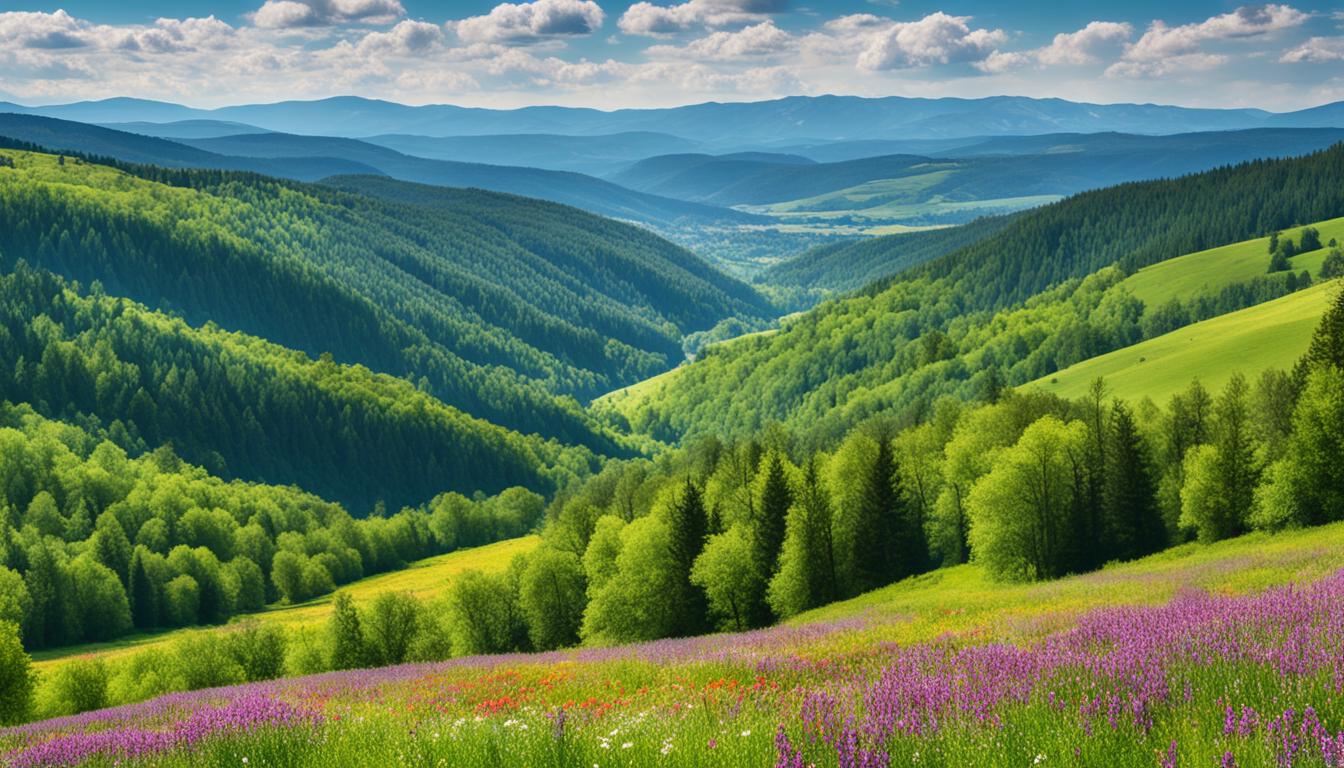


















Post comments (0)